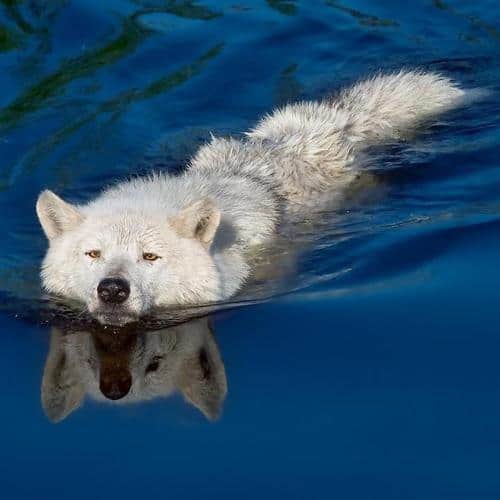If you’ve seen a wolf swim, it may seem unusual. we’re usually aware of wolves living in more forested and mountainous regions, so do wolves swim? And if so then how far and for what reason?
I’ve been exploring and researching this topic and will help explain more to you in this article, starting with the quick answer…
All wolves are comfortable in the water and are excellent swimmers. They can swim up to 8 miles and can withstand icy water. Usually, they swim to traverse water obstacles or pursue prey, and up to 25% of their diet is from water. Sea wolves are more proficient swimmers, their diet is 90% seafood.
That summary might invoke more questions, and it’s similar to another article I wrote on whether wolves can climb trees.
So let’s tackle all the additional swimming questions next.
How wolves swim
In general, much like dogs, all wolves can swim and have similar skills designed for swimming in the same way dogs do.
Wolves swim with the help of their paws and body weight. The type of wolf, their build, and their weight often determine how well they can swim.
How they swim is largely determined by how deep or shallow the water is. Wolves will wade – or bound through shallow streams. Or, in deeper waters, such as lakes, or the sea, they will adopt a more swim style technique.
Why wolves swim
One common reason why wolves swim is to help maintain their daily portion of meals. Many believe wolves just eat obvious animals like elk or deer. But in reality, wolves have a varied diet.
Depending on their location, up to 20% of the Alaskan coastal wolf’s diet consists of fish like salmon. but can also include seals, river otters, clams, herring eggs, and even scavenging on whale carcasses.
Here’s my article which gives a list of what a wolf eats. There are some interesting species on there!
How far wolves swim
The furthest known recording of a wolf swimming was over a distance of 7.5 miles (12 km). Depth is not a factor as they swim while keeping their head above the surface. Only obstacles such as strong currents, breaking waves, or predators would impede or prevent them from swimming.

Do all wolves’ species swim?
In general terms, all types of wolves swim in order to fill a part of their diet. However, the “Coastal wolf” also called the “sea wolf”, is well known for its regular swimming behavior.
But, sea wolves are much rarer than other species of wolves. Their numbers have declined and are now found almost exclusively With few exceptions, such as the possible existence of the Australian wolf.
Here are 20 Quick Facts About Wolves
Sea wolves
Seawolves have adapted to become genetically different from other wolves. This makes them a truly unique subspecies of wolves – and not just as the type of wolves that are great swimmers.
Seawolves have evolved into two main varieties, being mainland coastal wolves and island coastal wolves.
In the case of mainland coastal wolves, although they are great swimmers, they spend most of their time inland.
Island coastal wolves, as the name suggests, spend most of the time swimming between small islands. With some searching, you can find these wolves among the small islands along the Canadian coastline. The coastal wolf habitat, though, is now centered around southeastern Alaska.
Both these types of coastal wolves are adapted to be proficient swimmers in order to catch their prey. These coastal wolves are the ones better adapted to swim for several miles to traverse islands, or to hunt.
Sea wolf diet from water
Most coastal wolves fill their diet with seafood, which means more than 90% of a coastal wolves’ diet comes from swimming and hunting in the sea. This diet pattern differs greatly from inland wolves
Wolves who inhabit more mountainous and wooded areas have an average weight of about 115 pounds, whereas the coastal wolves have an average weight of 75-80 pounds. This weight gives coastal wolves the best weight, strength, and agility ratio to provide optimum stamina and performance when swimming.
Are some wolves “water dogs?”
Waterdogs is a vague term applied to wolves because they are excellent swimmers.
Coastal wolves are proficient swimmers because they have more greatly perfected the art of swimming for a long time, further, and in deeper water in order to catch prey.
The term water dogs mostly refer to species who prefer only shallow water where they can touch the bottom. Here they can wade, paddle, bathe and hunt.
But wolves, in general, have a much greater ability and desire to swim in order to hunt, catch prey, and survive. Rather than just paddling.
But how fast can a wolf swim? Let’s look at that next…
How fast can a wolf swim?
A wolf in deep but calm water, in full swimming mode, can attain a speed between 3-5 mph, depending on its strength and other factors. They can also leap (or bound) across shallow depths such as streams.

Related articles
Learning resources
We’ve found the ideal resources on amazon to continue your learning at home and at school. Help support our efforts for wildlife causes and keep this site working for nature.
Want to learn more about wolves in general? Increase your knowledge about wolves and get educated further with these fascinating books on Amazon.
Wolves: Behavior, Ecology, and Conservation
To close
We hope this has provided a thorough answer to the question “do wolves swim”. As well as information on which ones, how far and other related wolf swimming facts.

